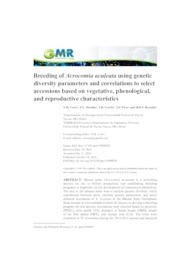Breeding of Acrocomia aculeata using genetic diversity parameters and correlations to select accessions based on vegetative, phenological, and reproductive characteristics.
Breeding of Acrocomia aculeata using genetic diversity parameters and correlations to select accessions based on vegetative, phenological, and reproductive characteristics.
Author(s): COSER, S. M.; MOTOIKE, S. Y.; CORRÊA, T. R.; PIRES, T. P.; RESENDE, M. D. V. de
Summary: Macaw palm (Acrocomia aculeata) is a promising species for use in biofuel production, and establishing breeding programs is important for the development of commercial plantations. The aim of the present study was to analyze genetic diversity, verify correlations between traits, estimate genetic parameters, and select different accessions of A. aculeata in the Macaw Palm Germplasm Bank located in Universidade Federal de Viçosa, to develop a breeding program for this species. Accessions were selected based on precocity (PREC), total spathe (TS), diameter at breast height (DBH), height of the first spathe (HFS), and canopy area (CA). The traits were evaluated in 52 accessions during the 2012/2013 season and analyzed by restricted estimation maximum likelihood/best linear unbiased predictor procedures. Genetic diversity resulted in the formation of four groups by Tocher?s clustering method. The correlation analysis showed it was possible to have indirect and early selection for the traits PREC and DBH. Estimated genetic parameters strengthened the genetic variability verified by cluster analysis. Narrow-sense heritability was classified as moderate (PREC, TS, and CA) to high (HFS and DBH), resulting in strong genetic control of the traits and success in obtaining genetic gains by selection. Accuracy values were classified as moderate (PREC and CA) to high (TS, HFS, and DBH), reinforcing the success of the selection process. Selection of accessions for PREC, TS, and HFS by the rank-average method permits selection gains of over 100%, emphasizing the successful use of the accessions in breeding programs and obtaining superior genotypes for commercial plantations.
Publication year: 2016
Types of publication: Journal article
Unit: Embrapa Forestry
Observation
Some of Embrapa's publications are published as ePub files. To read them, use or download one of the following free software options to your computer or mobile device. Android: Google Play Books; IOS: iBooks; Windows and Linux: Calibre.
Access other publications
Access the Agricultural Research Database (BDPA) to consult Embrapa's full library collection and records.
Visit Embrapa Bookstore to purchase books and other publications sold by Embrapa.

